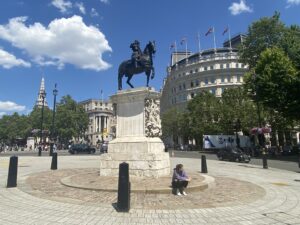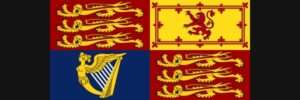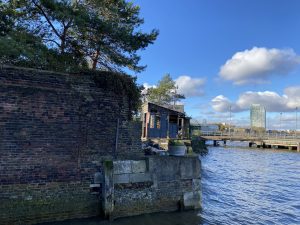The wizarding world of Harry Potter has so many levels, from the books, films, Warner Brother and Universal studios, a stage play and also walking tours in London.
Shrunken heads in Harry Potter
Shrunken heads are a lively addition to the film Harry Potter and the Prisoner of Azkaban but they don’t appear in the Harry Potter books or any other of the films. I want to share with you my findings on shrunken heads not only in the Harry Potter films but also where to see them in London.
Heads mounted on walls
The small heads which do feature in the books are the heads of the house-elves of the Black family for 135 years; between the years of Elladora Black, 1850 (Sirius’ great-great-great aunt) and Wallburga Black, 1985 (Sirius’ mother). It was Elladora who started the family tradition of cutting the heads off of the house-elves when they were too old to carry tea trays. Their heads were hung on plaques on the walls of 12 Grimmalud Place. Kreacher, the current Black family house-elf, had a lucky escape and was the first Black family house-elf to die naturally.
In the film, Harry Potter and the Order of the Phoenix, the Black family house-elves heads aren’t displayed on the walls but in dusty glass domes up the staircase of 12 Grimmauld place. Would the sight of near-to-human looking heads on wooden mounts push the film above the comfortable 12 rating?
In Harry Potter and the Chamber of Secrets Harry goes diagonally and ends up in Knockturn Alley where he noticed some shrunken heads on display in a shop window across from Borgin and Burkes antique shop. One of these, Heady, is Dre Head’s cousin, even though I can’t see the family resemblance myself.
Talking shrunken heads
It isn’t until Harry Potter and the Prisoner of Azkaban that Harry encounters a talking shrunken head by the name of Dre Head on the Knight Bus journey from Little Whinging to the Leaky Cauldron in London. You may remember that Dre Head has his eyes sewn closed, as traditional shrunken heads would have and yet he has the amazing ability to see, much to the benefit of Ernest Prang the visually challenged Knight Bus driver, “Ernie, little old lady at twelve o’clock!” The Jamaican accent is provided by the comedian actor Lenny Henry. Why a Jamaican accent? Who knows! Perhaps his native Dudley accent would have been equally exotic?
My favourite Dre Head joke, however, was sadly cut from the film.
As you can see Dre Head was animated with a model in place for positioning. Recognise the buildings the Knight Bus drives past in that scene? Come on one of my Harry Potter London walks to find out more.
There are some rather opinionated shrunken heads hanging inside the main door to the Three Broomsticks in Hogsmeade. They stop Ron and Hermione entering and following Harry who is wearing his invisibility cloak:
Shrunken Head: “I say! No underage wizards allowed in today! Shut the damn door!”
Hermione: “So rude.”
Ron: “Thick heads.”
Brian Bowles and Peter Serafinowicz provide the voices of the shrunken heads in the film. Bowles also plays the Headless Horseman in the same film. Ironic?
Where do shrunken heads originate?
Traditionally, shrunken heads were made by the Jivaro tribes, based in the Amazon, in areas which are now part of Ecuador and Peru. They were made during an elaborate celebratory ritual, over a slain enemy, often territorial based. When the warrior kills his enemy, he is not only after the victim’s life, but more importantly he seeks to possess the victim’s soul.
Before Columbia was formed in 1810, the art of shrinking heads was widespread throughout the Andes. Early accounts share detailed descriptions of shrunken heads and the meticulous methods used.
Shrunken heads, otherwise known as tsantas, were believed to possess magical powers (tsarutuma). After a battle the victor would take the head of his fallen enemy as a trophy. Many Shuar and Achuar Indians would consider a victory over the enemy as incomplete if they were unable to return without one or more so-called trophies.
Possessing the tsantsa was believed the spirits of his dead relatives would bestow him and his family with good crops and fortune.
The purpose of a shrunken head
The Shuar and Achuar indians gave much more thought to the harm that might come to them through the will of the neglected dead relatives’ ghosts than they did to the malevolent actions of any ghost of an enemy.
The preparation of the tsantsa is designed to trap the spirit of the fallen enemy within the head so that it cannot escape and take revenge on its murderer. Shrinking the head was believed to also prevent the spirit from continuing into the afterlife where it could harm the spirit ancestors of the victor. Which is why the eyes are sewn and their mouth sewn or pinned shut.
Acquiring trophies after a battle, was also an instrument of increasing a warrior’s own personal power, known as arutam. The idea behind killing the enemy and taking his head as a trophy, brings the victim’s arutam to the warrior. The power of the dead man’s soul is still considered dangerous to the victorious tribe and therefore the motive behind shrinking the head of the enemy is to conquer and destroy the spirit or soul.
Shrunken head ceremony
The head was then strung on a cord and worn at three ritual feasts, held over the course of a year or more, by the victor. The ceremony fell into three separate sections, each lasting several days. The warriors smeared themselves with blood and danced with the shrunken heads of their enemies dramatizing the killing.
The ceremonies held with the tsantsa were to show the spirit of the ancestors that the Shuar and Achuar are successfully fulfilling their obligations of blood revenge and increasing their own prestige.
The possession of the trophy enabled the warrior to be singled out in admiration amongst his peers. Surprisingly, despite the amount of effort that went into the preparation of the tsantsa and celebratory feasts, immediately following the final celebration, the heads were often discarded with relative indifference to the children or eventually lost.
There is no risk of decapitation when visiting Ecuador and Peru as the tradition seems to have stopped in the 1960s.
See the makings of a shrunken head with this recreation by The National Geographic.
Where can I see shrunken heads in London?
Even though the Science Museum no longer display tsantsas. Both the British Museum and the Wellcome Collection’s online library documents a number of shrunken heads.
But is it at The Viktor Wynd’s Museum of Curiosities where you strike gold. It is the country’s only curiosity museum and is open Wednesday – Sunday 12 noon – 10.30pm.
You may or may not be surprised that there is a Flickr group dedicated to shrunken heads: Shrunken heads Flickr groups
Make your own shrunken head
I have made my own shrunken heads which you can also do. These homemade shrunken heads take little effort, can be done on a budget and are really effective. Plus they are fun to do!
You will need:
Materials: Apples | Lemon Juice | 2 tbsp salt | Cloves
Tools: small knife | skewer | garden wire
Method:
- Dissolve salt in lemon juice of 2 lemons
- Soak apples for 20 mins in the solution – this minimises the apples turning brown
- Carve out faces, add cloves for detail. Don’t forget the mouth of a shrunken head would be pinned closed to stop the spirit within from reaching to its spirit ancestors. Use cloves to pin peelings for hair to the top of the apple.
- Use the skewer to create a hole through the side of the apple. I used a cake tester as the apples were soft enough.
- Thread garden wire or string through the head and hang to dry and watch the wrinkles develop. Alternatively if you wish to fill your kitchen with the aroma of apple pie, pop the heads in a low oven for 2 hours.
Make your own shrunken heads. SHRUNKEN HEADS ‘HOW TO’ GUIDE
Buy your Making of Harry Potter Tour tickets at the Warner Bros. Studios here
Related blog posts:
- Five Fantastic Questions I Get Asked on my Harry Potter in London walks
- Fantastic Beasts – Where to Find Them in London
For your own event or venue to be featured contact Hazel: blog@londonguidedwalks.co.uk



